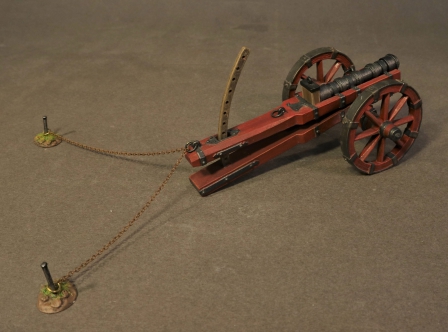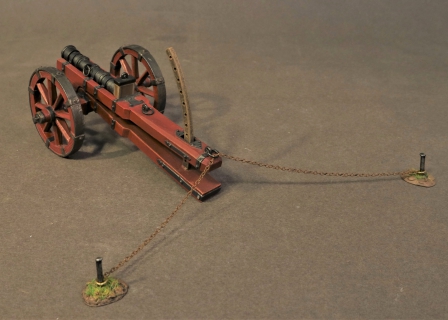 >
>
THE WARS OF THE ROSES 1455-1487
THE BATTLE OF BOSWORTH FIELD 1485
WORGUN-01
Breach Loading Field Cannon
(5 pcs)
US$51
THE WARS OF THE ROSES 1455-1487
The Wars of the Roses
were a series of dynastic wars for the throne of England.
They were fought between supporters
of two rival branches of the royal House of Plantagenet,
the houses of Lancaster and York.
They were fought in several sporadic episodes between 1455 and 1487,
although there was related fighting before and after this period.
The conflict resulted from social and financial troubles
that followed the Hundred Years' War,
combined with the mental infirmity and weak rule of Henry VI,
which revived interest in the alternative
claim to the throne of Richard, Duke of York.
The final victory went to a claimant of the Lancastrian party
, Henry Tudor, who defeated the last Yorkist king,
Richard III, at the Battle of Bosworth Field.
After assuming the throne as Henry VII,
Henry Tudor married Elizabeth of York,
the eldest daughter and heiress of Edward IV,
thereby uniting the two claims.
The House of Tudor ruled England and Wales until 1603.
THE BATTLE OF BOSWORTH FIELD 1485
The Battle of Bosworth (or Bosworth Field)
was the last significant battle of the Wars of the Roses,
the civil war between the Houses of Lancaster and York
that raged across England in the latter half of the 15th century.
Fought on 22 August 1485,
the battle was won by the Lancastrians.
Their leader Henry Tudor,
Earl of Richmond,
by his victory became the first English monarch of the Tudor dynasty.
His opponent, Richard III,
the last king of the House of York,
was killed in the battle.
Historians consider Bosworth Field to mark the end of the Plantagenet dynasty,
making it a defining moment of English and Welsh history.
LIVERIES AND BADGES
By the time of the Wars Of The Roses,
badges were of considerable importance.
These along with the Livery Colours were closely associated with what was
then known as Livery and Retaining (Bastard Feudalism).
The badges were rarely worn by their owners,
for they were marks of ownership.
They were, however, worn by his servants,
house-hold men, retainers,
and probably temporarily by the adherents to his cause.
So great and extensive was the use of these badges,
that they were far more generally employed than the coat of arms.
For where a man's badge would be
common knowledge and bear some repute throughout the kingdom,
few people would know what his coat of arms looked like.
HERALDIC BANNERS, BANNERS AND STANDARDS
There were 3 main types of flags used during the Wars of The Roses.
The largest was known as the Heraldic Banner,
and was used solely for displaying the coats of arms.
This was normally square and made with stiffened buckram with a batton along the top.
Therefore it was always on the fly,
so the standard bearer did not have to wave the banner about,
which gave him a spare hand in which he could brandish a weapon,
so he would be able to defend himself and the banner.
The Banner was a smaller version of the Heraldic Banner,
and usually only carried one large badge or device.
The field was often in the colour of the livery,
but this was not a rule.
The third type was known as a standard, and was a long swallow tailed style.
ARTILLERY
By the start of the WARS OF THE ROSES in the late 1450s,
artillery had been in use in northern Europe for over a century,
and most armies included at least a small artillery force.
Because one pound of powder was required to throw nine pounds of shot,
and because the barrel had to be washed
with a mixture of water and vinegar after every firing,
ten shots per hour was considered a good rate of fire.
During the Wars of the Roses,
this slow rate meant that cannon were used mainly on the eve
or at the start of a battle,
firing one volley at the enemy before the hand-to-hand combat commenced.
Experts in medieval gunnery suspect that the artillery
played a role at the beginning of the battle- but
may have become less useful tactically as the battle progressed.
It was notoriously difficult to turn
the artillery pieces round to face new directions - so
adapting to the progress of the battle
would have been difficult for these early gunners.
Their artillery pieces and carriages would probably
have weighed between 400 and 1000 kilos each.
Cannon appears to have been used extensively
by both sides at the Battle of Bosworth Field.
The present position of the battlefield is based
on the discovery in a field by Fenn Lane Farm
of a large quantity of battle relics including many cannon balls.
One account mentions 140 cannon,
while the archaeological searches of the battlefield
have found more than 30 cannonshot - more than
any other discovered on a European medieval battlefield.

We now accept PAYPAL,
to purchase your figures please send your order by e-mail to
inquiry@johnjenkinsdesigns.com
after checking that everything is available,
you will be billed via PAYPAL.
your order will be shipped on confirmation of payment.
worldwide airmail 15%
(minimum postage us$15)
JOHN JENKINS DESIGNS
UNIT 6E, TOWER 2,
KING LEY INDUSTRIAL BUILDING,
33-35 YIP KAN STREET,
WONG CHUK HANG,
HONG KONG
Tel: 852 9041 9065
